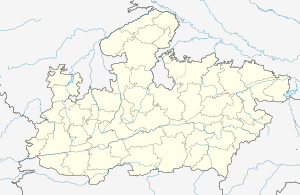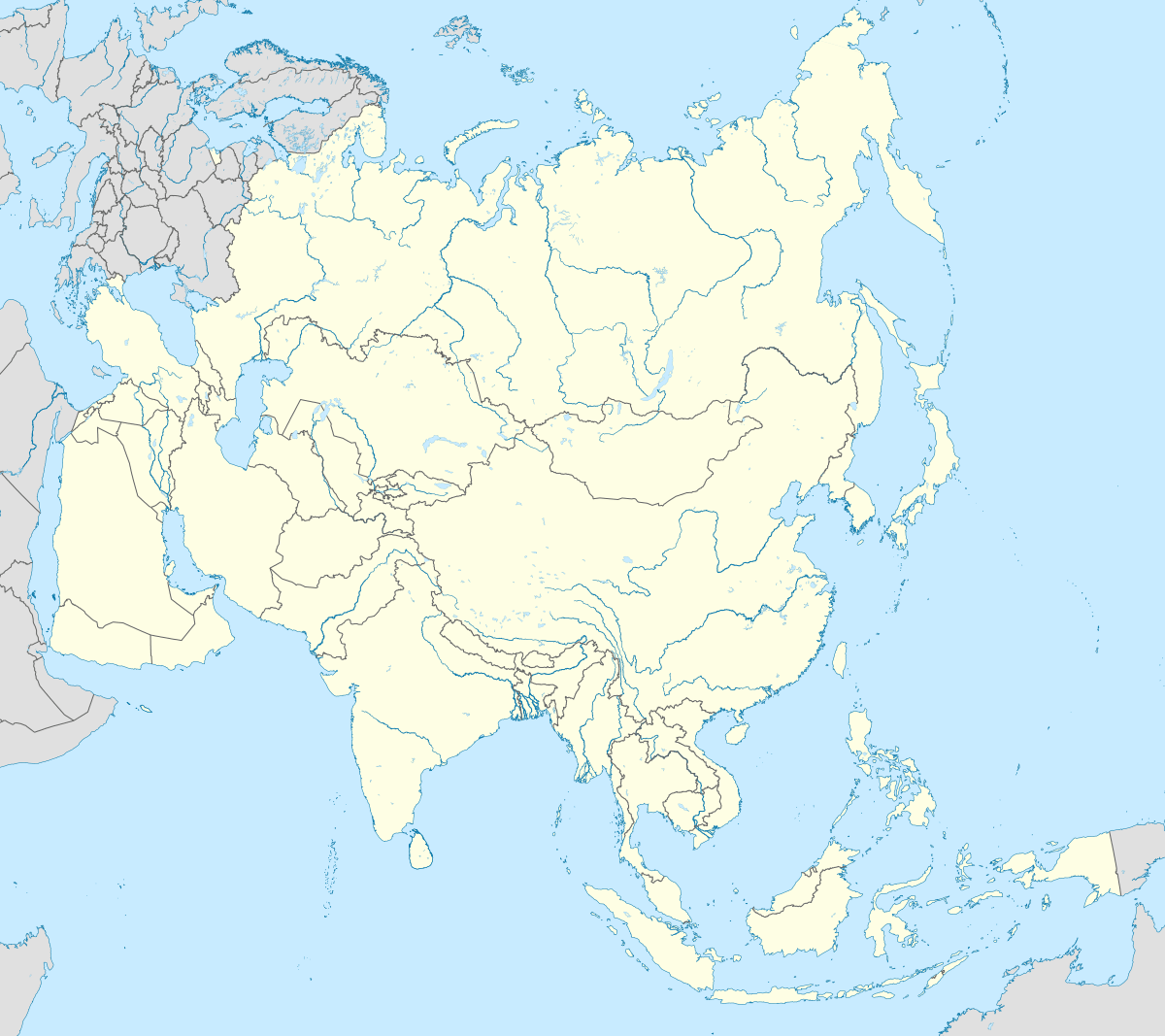Sagar, Madhya Pradesh
Sagar (formerly Saugor) is a city in the state of Madhya Pradesh in central India. Situated on a spur of the Vindhya Range and 1,758 feet (536 m) above sea-level. The city is around 172 kilometres (107 mi) northeast of state capital, Bhopal. It is situated almost in the centre of Republic of India.
Sagar, Madhya Pradesh Saugor | |
|---|---|
City | |
   | |
| Coordinates: 23.83°N 78.71°E | |
| Country | India |
| State | Madhya Pradesh |
| District | Sagar |
| Government | |
| • Type | Mayor–Council |
| • Body | Sagar Municipal Corporation |
| • Mayor | Abhay Dare |
| Area | |
| • Metro | 49.763 km2 (19.214 sq mi) |
| Elevation | 427 m (1,401 ft) |
| Population (2011) | |
| • City | 370,296 |
| • Density | 232/km2 (600/sq mi) |
| Language | |
| • Official | Hindi[1] |
| Time zone | UTC+5:30 (IST) |
| PIN | 470001,2,3,4 |
| Telephone code | 91 7582 |
| Vehicle registration | MP-15 |
| Website | www |
Sagar has been selected as one of the hundred Indian cities to be developed as a smart city under PM Narendra Modi's flagship Smart Cities Mission and listed top safest city of India 2018. Sagar University was founded on 18 July 1946. In February 1983 the name was changed to Dr. Hari Singh Gour University.
Etymology
The original name 'Saugor' (Hindi: सौगढ़) is an amalgamation of two words: sau meaning Hundred (100) and garh meaning forts; there were countless small-forts in this region. With time the name changed from Saugor to Sagar.[2][3]
History
The ancient Indian kingdom of Chedi had its capital at Suktimati, which is located in Sagar in contemporary times. The history of Sagar District before 1022 A.D. is generally unknown; after that, records are available. Sagar was under the rule of Ahir Rajas and their capital was at Garhpehra. In 1660, Udenshah, founded the present town of Sagar.[4]
After 1735, the city came under the rule of the Peshwas. In 1818, a large part of the Sagar district was ceded by Peshwa Baji Rao II to the British East India Company. Administratively, the position of Sagar and the neighbouring territories underwent frequent changes.
The Saugor territory was, first of all, placed under the superintendent of Political Affairs of Bundelkhand. Later, in 1820, this area, called the Saugor and Nerbudda Territories, was placed under the administration of an agent to the governor general. The region fell under the North-Western Provinces following its constitution in 1835. In 1842 occurred the Bundela rising, the quelling of which demanded a more direct attention by the Governor-General. But order was restored in the following year, and the Saugor and Nerbudda Territories were again placed under the political control of an Agent to the Governor-General. The arrangement however, was not found to be satisfactory and these territories were once again restored to the North-Western Provinces in 1853. Thereafter in 1861 the Saugor and Nerbudda territories, along with the Nagpur state formed a Commissioner's Province called Central Provinces.[5]
Climate
Sagar has humid subtropical climate (Köppen climate classification Cwa) with hot summers, a somewhat cooler monsoon season and cool winters. Very heavy rain falls in the monsoon season from June to September.
| Climate data for Sagar | |||||||||||||
|---|---|---|---|---|---|---|---|---|---|---|---|---|---|
| Month | Jan | Feb | Mar | Apr | May | Jun | Jul | Aug | Sep | Oct | Nov | Dec | Year |
| Record high °C (°F) | 32.3 (90.1) |
35.0 (95.0) |
39.1 (102.4) |
42.8 (109.0) |
46.0 (114.8) |
47.0 (116.6) |
40.0 (104.0) |
35.3 (95.5) |
38.1 (100.6) |
36.0 (96.8) |
34.6 (94.3) |
30.6 (87.1) |
47.0 (116.6) |
| Average high °C (°F) | 24.5 (76.1) |
26.7 (80.1) |
32.2 (90.0) |
37.8 (100.0) |
40.6 (105.1) |
37.2 (99.0) |
30.2 (86.4) |
28.6 (83.5) |
30.4 (86.7) |
31.6 (88.9) |
28.7 (83.7) |
25.1 (77.2) |
31.1 (88.1) |
| Daily mean °C (°F) | 17.3 (63.1) |
19.9 (67.8) |
25.3 (77.5) |
30.6 (87.1) |
33.5 (92.3) |
31.4 (88.5) |
26.7 (80.1) |
25.6 (78.1) |
26.3 (79.3) |
25.9 (78.6) |
22.4 (72.3) |
18.3 (64.9) |
25.3 (77.5) |
| Average low °C (°F) | 10.2 (50.4) |
13.0 (55.4) |
18.3 (64.9) |
23.3 (73.9) |
26.3 (79.3) |
25.4 (77.7) |
23.2 (73.8) |
22.5 (72.5) |
22.1 (71.8) |
20.2 (68.4) |
16.0 (60.8) |
11.5 (52.7) |
19.3 (66.8) |
| Record low °C (°F) | 4.6 (40.3) |
4.9 (40.8) |
9.8 (49.6) |
14.3 (57.7) |
18.3 (64.9) |
18.1 (64.6) |
19.9 (67.8) |
16.6 (61.9) |
17.0 (62.6) |
12.1 (53.8) |
9.1 (48.4) |
2.5 (36.5) |
2.5 (36.5) |
| Average precipitation mm (inches) | 27 (1.1) |
14 (0.6) |
4 (0.2) |
2 (0.1) |
16 (0.6) |
170 (6.7) |
350 (13.8) |
467 (18.4) |
162 (6.4) |
33 (1.3) |
19 (0.7) |
15 (0.6) |
1,279 (50.5) |
| Average rainy days | 2.3 | 2.3 | 0.8 | 0.2 | 1.9 | 9.6 | 16.5 | 19.7 | 10.0 | 2.2 | 0.9 | 1.2 | 67.6 |
| Average relative humidity (%) | 49 | 43 | 32 | 25 | 29 | 55 | 81 | 86 | 75 | 52 | 43 | 49 | 52 |
| Source: NOAA (1971-1990)[6] | |||||||||||||
Demographics
As of the 2011[7] India census, Sagar had a population of 2,378,458 of which male and female were 1,256,257 and 1,122,201 respectively. In the 2001 census, Sagar had a population of 2,021,987 of which males were 1,073,205 and remaining 948,782 were females. Average literacy rates of Sagar in 2011 were 76.46 compared to 67.73 of 2001. Gender-wise, male and female literacy rates were 84.85 and 67.02 respectively in 2011. For the 2001 census, the rates stood at 79.41 and 54.35 in Sagar District. The total number of literates in Sagar District were 1,545,719 of which male and female were 908,607 and 637,112 respectively. In 2001, Sagar District had 1,118,993 literates in its district.
Notable people
- Gopal Bhargava, Indian politician
- Govind Namdev, Television and film actor
- Mahendra Mewati, Theatre and film actor
- Mukesh Tiwari, Theatre and film actor
- Virendra Kumar Khatik, Indian politician
- Dr. Ashok Bamorya, Chief Medical Officer
- Anil Jain Naindhara, Social Workerband Politician
References
- "52nd REPORT OF THE COMMISSIONER FOR LINGUISTIC MINORITIES IN INDIA" (PDF). nclm.nic.in. Ministry of Minority Affairs. Archived from the original (PDF) on 25 May 2017. Retrieved 17 June 2019.
- "About Sagar". Retrieved 26 August 2014.
- "Sagar Places To Visit". www.touristlink.com. Tourist Link.
- Arun K. Jain, A. N. Sharma (2006). The Beria (Rai Dancers): A Socio-demographic, Reproductive, and Child Health Care Practices Profile. Berias. Sarup & Sons. p. 13. ISBN 9788176257145. Retrieved 15 October 2014.
- "History of Sagar". sagar.nic.in. Retrieved 17 May 2019.
- "Sagar Climate Normals 1971-1990". National Oceanic and Atmospheric Administration. Retrieved 22 December 2012.
- "Sagar District Population Census 2011, Madhya Pradesh literacy sex ratio and density". Retrieved 5 August 2016.
- "Sagar Religion Census 2011". no. Census 2011 India. Archived from [no the original] Check
|url=value (help) on 12 June 2007.